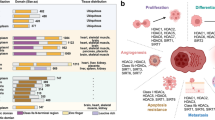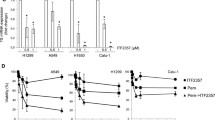Abstract
Evasion of apoptosis can be caused by epigenetic silencing of caspase-8, a key component of the extrinsic apoptosis pathway. Loss of caspase-8 correlates with poor prognosis in medulloblastoma, which highlights the relevance of strategies to upregulate caspase-8 to break apoptosis resistance. Here, we develop a new combinatorial approach, that is treatment using histone deacetylase inhibitors (HDACI) together with interferon (IFN)-γ, to restore caspase-8 expression and to overcome resistance to the death-receptor ligand TNF-related apoptosis-inducing ligand (TRAIL) in medulloblastoma in vitro and in vivo. HDACI, for example, valproic acid (VA), suberoylanilide hydroxamic acid (SAHA) and MS-275, cooperate with IFN-γ to upregulate caspase-8 in cancer cells lacking caspase-8, thereby restoring sensitivity to TRAIL-induced apoptosis. Molecular studies show that VA promotes histone acetylation and acts in concert with IFN-γ to stimulate caspase-8 promoter activity. The resulting increase in caspase-8 mRNA and protein expression leads to enhanced TRAIL-induced activation of caspase-8 at the death-inducing signaling complex, mitochondrial outer-membrane permeabilization and caspase-dependent cell death. Intriguingly, pharmacological or genetic inhibition of caspase-8 also abolishes the VA/IFN-γ-mediated sensitization for TRAIL-induced apoptosis. It is important to note that VA and IFN-γ restore caspase-8 expression and sensitivity to TRAIL in primary medulloblastoma samples and significantly potentiate TRAIL-mediated suppression of medulloblastoma growth in vivo. These findings provide the rationale for further (pre)clinical evaluation of VA and IFN-γ to restore caspase-8 expression and apoptosis sensitivity in cancers with caspase-8 silencing and open new perspectives to overcome TRAIL resistance.






Similar content being viewed by others
References
Adams JM, Cory S . (2007). The Bcl-2 apoptotic switch in cancer development and therapy. Oncogene 26: 1324–1337.
Ashkenazi A . (2008). Targeting the extrinsic apoptosis pathway in cancer. Cytokine Growth Factor Rev 19: 325–331.
Ashkenazi A, Herbst RS . (2008). To kill a tumor cell: the potential of proapoptotic receptor agonists. J Clin Invest 118: 1979–1990.
Banelli B, Casciano I, Croce M, Di Vinci A, Gelvi I, Pagnan G et al. (2002). Expression and methylation of CASP8 in neuroblastoma: identification of a promoter region. Nat Med 8: 1333–1335.
Blaheta RA, Cinatl Jr J . (2002). Anti-tumor mechanisms of valproate: a novel role for an old drug. Med Res Rev 22: 492–511.
Bolden JE, Peart MJ, Johnstone RW . (2006). Anticancer activities of histone deacetylase inhibitors. Nat Rev Drug Discov 5: 769–784.
Fulda S . (2008). Caspase-8. In: Schwab M (ed). Encyclopedia of Cancer. Springer: Berlin.
Fulda S, Debatin K-M . (2002). IFNgamma sensitizes for apoptosis by upregulating caspase-8 expression through the Stat1 pathway. Oncogene 21: 2295–2308.
Fulda S, Debatin KM . (2006a). 5-Aza-2′-deoxycytidine and IFN-gamma cooperate to sensitize for TRAIL-induced apoptosis by upregulating caspase-8. Oncogene 25: 5125–5133.
Fulda S, Debatin KM . (2006b). Extrinsic versus intrinsic apoptosis pathways in anticancer chemotherapy. Oncogene 25: 4798–4811.
Fulda S, Debatin KM . (2006c). Therapeutic modulation of apoptosis in cancer therapy. In: Fulda S, Debatin KM (eds). Apoptosis and Cancer Therapy. Wiley-VCH: Weinheim. pp 515–535.
Fulda S, Kufer MU, Meyer E, van Valen F, Dockhorn-Dworniczak B, Debatin KM . (2001). Sensitization for death receptor- or drug-induced apoptosis by re-expression of caspase-8 through demethylation or gene transfer. Oncogene 20: 5865–5877.
Fulda S, Meyer E, Debatin KM . (2002). Inhibition of TRAIL-induced apoptosis by Bcl-2 overexpression. Oncogene 21: 2283–2294.
Fulda S, Sieverts H, Friesen C, Herr I, Debatin KM . (1997). The CD95 (APO-1/Fas) system mediates drug-induced apoptosis in neuroblastoma cells. Cancer Res 57: 3823–3829.
Giagkousiklidis S, Vogler M, Westhoff MA, Kasperczyk H, Debatin KM, Fulda S . (2005). Sensitization for gamma-irradiation-induced apoptosis by second mitochondria-derived activator of caspase. Cancer Res 65: 10502–10513.
Gottlicher M, Minucci S, Zhu P, Kramer OH, Schimpf A, Giavara S et al. (2001). Valproic acid defines a novel class of HDAC inhibitors inducing differentiation of transformed cells. EMBO J 20: 6969–6978.
Grotzer MA, Eggert A, Zuzak TJ, Janss AJ, Marwaha S, Wiewrodt BR et al. (2000). Resistance to TRAIL-induced apoptosis in primitive neuroectodermal brain tumor cells correlates with a loss of caspase-8 expression. Oncogene 19: 4604–4610.
Guerrini R . (2006). Valproate as a mainstay of therapy for pediatric epilepsy. Paediatr Drugs 8: 113–129.
Hengartner MO . (2000). The biochemistry of apoptosis. Nature 407: 770–776.
Hopkins-Donaldson S, Ziegler A, Kurtz S, Bigosch C, Kandioler D, Ludwig C et al. (2003). Silencing of death receptor and caspase-8 expression in small cell lung carcinoma cell lines and tumors by DNA methylation. Cell Death Differ 10: 356–364.
Jiang M, Zhu K, Grenet J, Lahti JM . (2008). Retinoic acid induces caspase-8 transcription via phospho-CREB and increases apoptotic responses to death stimuli in neuroblastoma cells. Biochim Biophys Acta 1783: 1055–1067.
Jonasch E, Haluska FG . (2001). Interferon in oncological practice: review of interferon biology, clinical applications, and toxicities. Oncologist 6: 34–55.
Krammer PH . (2000). CD95's deadly mission in the immune system. Nature 407: 789–795.
Kroemer G, Galluzzi L, Brenner C . (2007). Mitochondrial membrane permeabilization in cell death. Physiol Rev 87: 99–163.
Kuefer R, Hofer MD, Altug V, Zorn C, Genze F, Kunzi-Rapp K et al. (2004). Sodium butyrate and tributyrin induce in vivo growth inhibition and apoptosis in human prostate cancer. Br J Cancer 90: 535–541.
Li X-N, Shu Q, Su JM-F, Perlaky L, Blaney SM, Lau CC . (2005). Valproic acid induces growth arrest, apoptosis, and senescence in medulloblastomas by increasing histone hyperacetylation and regulating expression of p21Cip1, CDK4, and CMYC. Mol Cancer Ther 4: 1912–1922.
Lissat A, Vraetz T, Tsokos M, Klein R, Braun M, Koutelia N et al. (2007). Interferon-gamma sensitizes resistant Ewing's sarcoma cells to tumor necrosis factor apoptosis-inducing ligand-induced apoptosis by up-regulation of caspase-8 without altering chemosensitivity. Am J Pathol 170: 1917–1930.
Meister N, Shalaby T, von Bueren AO, Rivera P, Patti R, Oehler C et al. (2007). Interferon-gamma mediated up-regulation of caspase-8 sensitizes medulloblastoma cells to radio- and chemotherapy. Eur J Cancer 43: 1833–1841.
Merchant MS, Yang X, Melchionda F, Romero M, Klein R, Thiele CJ et al. (2004). Interferon gamma enhances the effectiveness of tumor necrosis factor-related apoptosis-inducing ligand receptor agonists in a xenograft model of Ewing's sarcoma. Cancer Res 64: 8349–8356.
Mohr A, Zwacka RM, Debatin KM, Stahnke K . (2004). A novel method for the combined flow cytometric analysis of cell cycle and cytochrome c release. Cell Death Differ 11: 1153–1154.
Nightingale KP, O'Neill LP, Turner BM . (2006). Histone modifications: signalling receptors and potential elements of a heritable epigenetic code. Curr Opin Genet Dev 16: 125–136.
Ozoren N, El-Deiry WS . (2002). Defining characteristics of Types I and II apoptotic cells in response to TRAIL. Neoplasia (New York) 4: 551–557.
Peter ME, Kischkel FC, Scheuerpflug CG, Medema JP, Debatin KM, Krammer PH . (1997). Resistance of cultured peripheral T cells towards activation-induced cell death involves a lack of recruitment of FLICE (MACH/caspase 8) to the CD95 death-inducing signaling complex. Eur J Immunol 27: 1207–1212.
Pingoud-Meier C, Lang D, Janss AJ, Rorke LB, Phillips PC, Shalaby T et al. (2003). Loss of caspase-8 protein expression correlates with unfavorable survival outcome in childhood medulloblastoma. Clin Cancer Res 9: 6401–6409.
Roth SY, Denu JM, Allis CD . (2001). Histone acetyltransferases. Annu Rev Biochem 70: 81–120.
Ruiz-Ruiz C, Munoz-Pinedo C, Lopez-Rivas A . (2000). Interferon-gamma treatment elevates caspase-8 expression and sensitizes human breast tumor cells to a death receptor-induced mitochondria-operated apoptotic program. Cancer Res 60: 5673–5680.
Rutkowski S, von Bueren A, von Hoff K, Hartmann W, Shalaby T, Deinlein F et al. (2007). Prognostic relevance of clinical and biological risk factors in childhood medulloblastoma: results of patients treated in the prospective multicenter trial HIT'91. Clin Cancer Res 13: 2651–2657.
Scaffidi C, Fulda S, Srinivasan A, Friesen C, Li F, Tomaselli KJ et al. (1998). Two CD95 (APO-1/Fas) signaling pathways. EMBO J 17: 1675–1687.
Shu Q, Antalffy B, Su JMF, Adesina A, Ou C-N, Pietsch T et al. (2006). Valproic Acid prolongs survival time of severe combined immunodeficient mice bearing intracerebellar orthotopic medulloblastoma xenografts. Clin Cancer Res 12: 4687–4694.
Smyth MJ, Takeda K, Hayakawa Y, Peschon JJ, van den Brink MRM, Yagita H . (2003). Nature's TRAIL—on a path to cancer immunotherapy. Immunity 18: 1–6.
Stupack DG, Teitz T, Potter MD, Mikolon D, Houghton PJ, Kidd VJ et al. (2006). Potentiation of neuroblastoma metastasis by loss of caspase-8. Nature 439: 95–99.
Teitz T, Wei T, Valentine MB, Vanin EF, Grenet J, Valentine VA et al. (2000). Caspase 8 is deleted or silenced preferentially in childhood neuroblastomas with amplification of MYCN. Nat Med 6: 529–535.
Tekautz TM, Zhu K, Grenet J, Kaushal D, Kidd VJ, Lahti JM . (2006). Evaluation of IFN-gamma effects on apoptosis and gene expression in neuroblastoma—preclinical studies. Biochim Biophys Acta 1763: 1000–1010.
Thiagalingam S, Cheng KH, Lee HJ, Mineva N, Thiagalingam A, Ponte JF . (2003). Histone deacetylases: unique players in shaping the epigenetic histone code. Ann NY Acad Sci 983: 84–100.
Van Boxel-Dezaire AH, Stark GR . (2007). Cell type-specific signaling in response to interferon-gamma. Curr Top Microbiol Immunol 316: 119–154.
Varfolomeev EE, Schuchmann M, Luria V, Chiannilkulchai N, Beckmann JS, Mett IL et al. (1998). Targeted disruption of the mouse Caspase 8 gene ablates cell death induction by the TNF receptors, Fas/Apo1, and DR3 and is lethal prenatally. Immunity 9: 267–276.
Vogler M, Durr K, Jovanovic M, Debatin KM, Fulda S . (2007). Regulation of TRAIL-induced apoptosis by XIAP in pancreatic carcinoma cells. Oncogene 26: 248–257.
Vogler M, Walczak H, Stadel D, Haas TL, Genze F, Jovanovic M et al. (2008). Targeting XIAP bypasses Bcl-2-mediated resistance to TRAIL and cooperates with TRAIL to suppress pancreatic cancer growth in vitro and in vivo. Cancer Res 68: 7956–7965.
Vogler M, Walczak H, Stadel D, Haas TL, Genze F, Jovanovic M et al. (2009). Small molecule XIAP inhibitors enhance TRAIL-induced apoptosis and antitumor activity in preclinical models of pancreatic carcinoma. Cancer Res 69: 2425–2434.
Wagner KW, Engels IH, Deveraux QL . (2004). Caspase-2 can function upstream of bid cleavage in the TRAIL apoptosis pathway. J Biol Chem 279: 35047–35052.
Wexler L, Thiele CJ, McClure L, Chanock S, Mertins S, Tsokos M et al. (1992). Adoptive immunotherapy of refractory neuroblastoma with tumor-infiltrating lymphocytes, interferon-{gamma}, and interleukin-2. Proc Ann Meet Am Soc Clin Oncol 11: 368.
Yang X, Merchant MS, Romero ME, Tsokos M, Wexler LH, Kontny U et al. (2003). Induction of caspase 8 by interferon gamma renders some neuroblastoma (NB) cells sensitive to tumor necrosis factor-related apoptosis-inducing ligand (TRAIL) but reveals that a lack of membrane TR1/TR2 also contributes to TRAIL resistance in NB. Cancer Res 63: 1122–1129.
Acknowledgements
We thank R Agami (The Netherlands Cancer Institute, Amsterdam, Netherlands) for providing pRETRO-SUPER vector, CA Schmitt (Berlin, Germany) for mouse Bcl-2 vector, M. Romani (Genova, Italy) for caspase-8 pBL-CAT3 promoter construct, Apoxis (Lausanne, Switzerland) for mega-Fas ligand and F Beguinot (Naples, Italy) for anti-PED antibody. This work has been partially supported by grants from the Deutsche Forschungsgemeinschaft, the Deutsche Krebshilfe, IAP6/18 and the European Community (ApopTrain, APO-SYS) (to SF).
Author information
Authors and Affiliations
Corresponding author
Additional information
Supplementary Information accompanies the paper on the Oncogene website (http://www.nature.com/onc)
Rights and permissions
About this article
Cite this article
Häcker, S., Dittrich, A., Mohr, A. et al. Histone deacetylase inhibitors cooperate with IFN-γ to restore caspase-8 expression and overcome TRAIL resistance in cancers with silencing of caspase-8. Oncogene 28, 3097–3110 (2009). https://doi.org/10.1038/onc.2009.161
Received:
Revised:
Accepted:
Published:
Issue Date:
DOI: https://doi.org/10.1038/onc.2009.161
- Springer Nature Limited
Keywords
This article is cited by
-
Anticancer activity of N-heteroaryl acetic acid salts against breast cancer; in silico and in vitro investigation
Molecular Biology Reports (2022)
-
BCL-2 selective inhibitor ABT-199 primes rhabdomyosarcoma cells to histone deacetylase inhibitor-induced apoptosis
Oncogene (2018)
-
DDIAS suppresses TRAIL-mediated apoptosis by inhibiting DISC formation and destabilizing caspase-8 in cancer cells
Oncogene (2018)
-
Targeting redox homeostasis in rhabdomyosarcoma cells: GSH-depleting agents enhance auranofin-induced cell death
Cell Death & Disease (2017)
-
A Bak-dependent mitochondrial amplification step contributes to Smac mimetic/glucocorticoid-induced necroptosis
Cell Death & Differentiation (2017)




